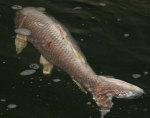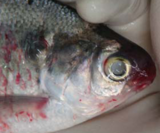Biology:Cyvirus cyprinidallo3
| Cyvirus cyprinidallo3 | |
|---|---|
| Virus classification | |
| (unranked): | Virus |
| Realm: | Duplodnaviria |
| Kingdom: | Heunggongvirae |
| Phylum: | Peploviricota |
| Class: | Herviviricetes |
| Order: | Herpesvirales |
| Family: | Alloherpesviridae |
| Genus: | Cyvirus |
| Species: | Cyvirus cyprinidallo3
|
| Synonyms | |
| |
Cyvirus cyprinidallo3, also known as Cyprinid herpesvirus 3 (CyHV-3) is a species in the Genus Cyvirus and the order Herpesvirales.[1] It causes a viral disease that is very contagious to the common carp Cyprinus carpio.
Pathology
It is most commonly found in ornamental koi, which are often used in outdoor ponds or as feeder stock. The first case of KHV was reported in 1998, but not confirmed until later in 1999.
KHV is a DNA-based virus. After discovery, it was identified as a strain of herpesvirus. Like other strains, KHV stays with the infected fish for the duration of their lives, making the recovered and exposed fish potential carriers of the virus. Koi fish infected with KHV may die within the first 24–48 hours of exposure. The virus is found in 33 countries.[2]
KHV is listed as a nonexotic disease of the EU, so is watched closely by the European Community Reference Laboratory for Fish Diseases.
Symptoms of KHV include:
- Gill mottling
- Red and white patches appearing on gills
- Bleeding gills
- Sunken eyes
- Pale patches
- Blisters
Changes in the specimen's behaviour may also indicate the presence of KHV. Behavioural symptoms may include disorientation, hyperactivity and potentially isolation, in which the specimen detaches themselves from the shoal.[3]
Use as a biological control agent
In 2016 the Australian government announced plans to release the virus into the Murray-Darling basin in an attempt to reduce the number of invasive common carp in the water system.[4][5] However in 2020 this plan was found to be unlikely to work.[6]
References
- ↑ "Virus Taxonomy: 2022 Release" (in en). March 2023. https://ictv.global/taxonomy.
- ↑ Thistleton, John (13 June 2016). "Millions of Lake Burley Griffin carp face swift death from cyprinid herpesvirus release". The Canberra Times (Fairfax Media). http://www.canberratimes.com.au/environment/animals/millions-of-lake-burley-griffin-carp-face-swift-death-from-cyprinid-herpesvirus-release-20160606-gpcs3e.html.
- ↑ "Koi Herpesvirus – KHV" (in en-GB). http://www.temporarysomiskoi.com/koi-herpes-virus-khv/.
- ↑ Kilvert, Nick; Thomas, Kerrin (1 May 2016). "Herpes virus to be used in fight against carp in Murray River, Christopher Pyne says". Australian Broadcasting Corporation. http://www.abc.net.au/news/2016-05-01/herpes-to-eradicate-carp-in-murray-river-pyne-says/7373736.
- ↑ "Carp herpesvirus". 2018-04-26. http://research.csiro.au/mwe/carp-herpesvirus/.
- ↑ Mintram, Kate S.; Oosterhout, Cock; Lighten, Jackie (2020-10-14). Knutie, Sarah. ed. "Genetic variation in resistance and high fecundity impede viral biocontrol of invasive fish". Journal of Applied Ecology (Wiley). doi:10.1111/1365-2664.13762. ISSN 0021-8901.
External links
- Invading Species.com Ontario Ministry of Natural Resources and the Ontario Federation of Anglers and Hunters
- Koi Herpes Virus (KHV) Disease. Institute of Food and Agricultural Sciences Fact Sheet VM-149, University of Florida.
- European Community Reference Laboratory for Fish Diseases
- Carp herpesvirus – Managing Water Ecosystems – CSIRO
Wikidata ☰ Q386469 entry
 |



